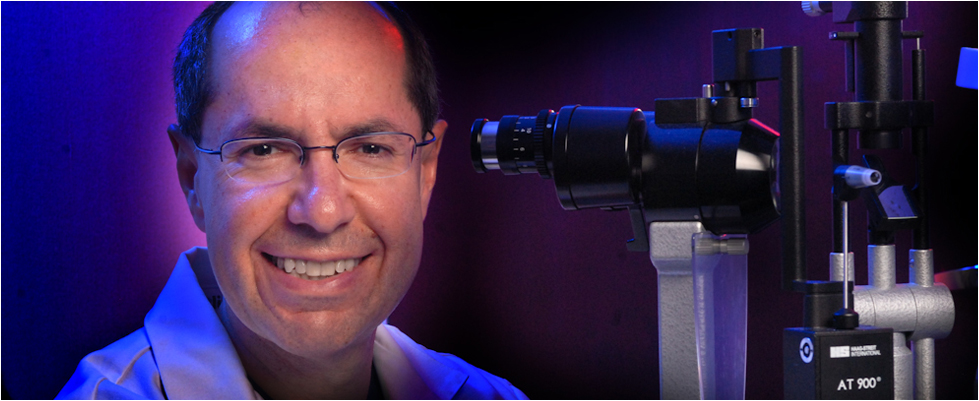The best way to maintain eye health and preserve your vision is to have regular and complete eye examinations with the appropriate level of diagnostic testing for glaucoma as recommended by the eye doctors at Baltimore Washington Eye Center. During your examination, our eye doctors and the staff may perform a number of tests in order to make the most accurate diagnosis for each patient. These include the following testing procedures:
Tonometry
The Tonometry Test is a method of measuring your Intraocular Pressure (IOP). This test involves first placing some eye drops on your eyes to numb them and then lightly touching the surface of the cornea with a specialized measuring instrument. There is no discomfort involved. The test is quick and gives the eye doctors the first piece of important information in determining whether you have glaucoma.
Ophthalmoscopy
Ophthalmoscopy is a method of carefully examining the inside of the eye, especially the optic nerve. Some eye drops will be placed in your eyes in order to dilate your pupils so that the doctors can make a clear and direct observation of the optic nerve. The examination will take place in a darkened room using different types of ophthalmoscopes in order to examine the shape and color of your optic nerve.
If either the Intraocular Pressure (IOP) is elevated or the optic nerve appears unusual, additional tests will be necessary in order to complete the glaucoma examination. These may include the following test procedures:
Visual Field Perimetry
Perimetry or Visual Field testing is an important part of the glaucoma examination. During this test you will be asked to sit in front of a large “bowl-like” instrument and look straight ahead.
A computer program will present a number of lights at different points of your “side” or peripheral vision to see how sensitive your side vision is in various directions. The computer will then plot an actual map of the field of vision so that your doctor can interpret this map in conjunction with other examination tests in order to understand how well the optic nerve is functioning. Glaucoma usually affects your side vision before your central vision, so visual field testing can often show any problems from glaucoma before you can notice them.
Gonioscopy
Gonioscopy is a quick and painless test that allows the doctors to directly observe the health and condition of the angle where the iris meets the cornea. By directly observing the angle and its status your eye doctor will know more about whether you are at risk for the angle to become closed or whether the Trabecular Meshwork appears to have a normal anatomical structure.
Optic Nerve Computer Imaging
At Baltimore Washington Eye Center, we use the most advanced computer imaging technology in order to make the earliest and most accurate diagnosis of glaucoma. Our Optic Nerve Computer Imaging system is called OCT or Optical Coherence Tomography. The OCT uses a method called “optical coherence tomography” that is capable of creating digital images through the use of special beams of light in order to create a contour map of the optic nerve and measure the retinal nerve fiber thickness. In many regards, this is similar to the CT Scans used to study organ systems and tissues throughout your body.
The goal of OCT Optic Nerve Computer Imaging is to give our eye doctors the ability to detect the slightest loss of optic nerve fibers, at the first possible moment, in order to diagnose Glaucoma at the earliest possible stage in order to stop the progression of the disease and preserve your vision.
We perform OCT Optic Nerve Computer Imaging right in the comfort and convenience of our office at Baltimore Washington Eye Center.
Pachymetry Measurement of Corneal Thickness
The National Eye Institute of the National Institutes of Health released a key study in 2002, called the Ocular Hypertension Study (OHTS). In this study, an important finding was made regarding corneal thickness and its role in Intraocular Pressure and the development of glaucoma.
The OHTS study found that corneal thickness is important because it can alter the accuracy of the measurement of Intraocular Pressure, potentially causing doctors to treat you for a condition that may not actually exist. Your actual Intraocular Pressure may be UNDERESTIMATED if you have thin corneas and it may be OVERESTIMATED if you have thicker corneas.
During a glaucoma examination, your doctor or a staff member may perform a Pachymetry Test to measure your corneal thickness as part of your examination and then consider this finding in conjunction with the other Glaucoma testing in order to make the most accurate diagnosis.
The Pachymetry Test is a simple, quick and painless way of accurately measuring your coneal thickness that we do right in our office. The test is performed by first placing some drops on your eyes to make them numb and then lightly touching the cornea with a “pencil like” probe that uses sound waves to precisely measure your corneal thickness.
If you or someone you know would like to learn more about the diagnosis and tests for glaucoma or needs an appointment for a glaucoma eye exam, please call Baltimore Washington Eye Center at 800-495-3937 to schedule an appointment.


